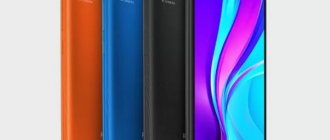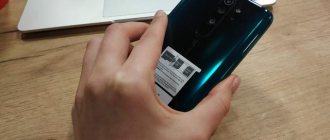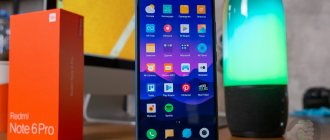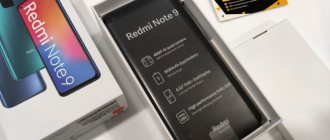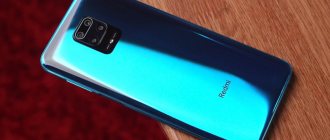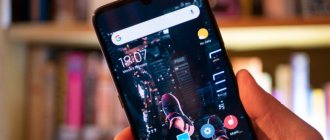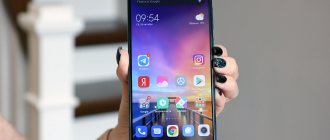In the Redmi Note 9S review, I already complained about the extreme complexity of the Xiaomi lineup, even within small subseries. This year, three Redmi Notes were released, sometimes differing in minor details.
Of the three, Redmi Note 9 stands out as a simpler and less expensive model: a 6.53-inch screen, MediaTek Helio G85 platform, a rear fingerprint scanner (that is, even externally it can be distinguished), and a 13-megapixel front camera. But the difference between Redmi Note 9S and 9 Pro is really only in the details: the Pro version received a more advanced rear camera with a 64-megapixel main module, a slightly different design in a couple of color variations (not the one we got for testing), faster charging and, perhaps most importantly, the NFC module. Well, the Pro does not have a version with 4 GB of RAM. The main features - be it the Qualcomm Snapdragon 720G platform, a 6.67-inch diagonal LCD display or a 16-megapixel front camera inscribed in the screen right in the center at the top - remained unchanged. Oddly enough, even such small changes are enough to greatly change the overall picture.
⇡#Technical characteristics
| Xiaomi Redmi Note 9 Pro | Xiaomi Redmi Note 9S | Xiaomi Redmi Note 8 Pro | realme 6 Pro | Huawei P40 lite | |
| Display | 6.67 inches, IPS, 2400 × 1080 pixels, 395 ppi; capacitive, multi-touch | 6.67 inches, IPS, 2400 × 1080 pixels, 395 ppi; capacitive, multi-touch | 6.53 inches, IPS, 2340 × 1080 pixels, 395 ppi; capacitive, multi-touch | 6.6 inches, IPS, 1080 × 2400, 399 ppi; capacitive multi-touch | 6.4 inches, IPS, 2310 × 1080 pixels (19:9), 398 ppi, capacitive multi-touch |
| Protective glass | Corning Gorilla Glass 5 | Corning Gorilla Glass 5 | Corning Gorilla Glass 5 | Corning Gorilla Glass 5 | no data |
| CPU | Qualcomm Snapdragon 720G: eight cores (2 × Kryo 465 Gold, 2.3 GHz and 6 × Kryo 465 Silver, 1.8 GHz) | Qualcomm Snapdragon 720G: eight cores (2 × Kryo 465 Gold, 2.3 GHz and 6 × Kryo 465 Silver, 1.8 GHz) | Mediatek Helio G90T: eight cores (2 × Cortex A76, 2.05 GHz + 6 × Cortex A55, 2.0 GHz) | Qualcomm Snapdragon 720G: eight cores (2 × Kryo 465 Gold, 2.3 GHz and 6 × Kryo 465 Silver, 1.8 GHz) | HiSilicon Kirin 810: eight cores (2 × Cortex-A76, 2.27 GHz + 6 × Cortex-A55, 1.88 GHz) |
| Graphics controller | Adreno 618 | Adreno 618 | ARM Mali-G56 MC4 | Adreno 618 | Mali-G52 MP6 |
| RAM | 6 GB | 4/6 GB | 6/8 GB | 8 GB | 6/8 GB |
| Flash memory | 64/128 GB | 64/128 GB | 64/128 GB | 128 GB | 128 GB |
| Connectors | USB Type-C, 3.5 mm mini-jack | USB Type-C, 3.5 mm mini-jack | USB Type-C, 3.5 mm mini-jack | USB Type-C, 3.5 mm | USB Type-C |
| Memory card slot | Yes (separate slot for microSD) | Yes (separate slot for microSD) | Yes (hybrid slot for microSD/second nano-SIM) | Yes (separate slot for microSD) | Yes (hybrid slot for nV/second nano-SIM) |
| SIM cards | 2 × nano-SIM | 2 × nano-SIM | 2 × nano-SIM | 2 × nanoSIM | 2 × nano-SIM |
| Cellular connection 2G | GSM/GPRS/EDGE 850/900/1800/1900 MHz | GSM/GPRS/EDGE 850/900/1800/1900 MHz | GSM/GPRS/EDGE 850/900/1800/1900 MHz | GSM/GPRS/EDGE 850/900/1800/1900 MHz | GSM 850/900/1800/1900 MHz |
| Cellular 3G | HSDPA 850/900/1700/1900/2100 MHz | HSDPA 850/900/1700/1900/2100 MHz | HSDPA 850/900/1900/2100 MHz | HSDPA 850/900/1700/1900/2100 MHz | HSDPA 800/850/900/1700/1900/2100 MHz |
| Cellular 4G | LTE, bands 1, 3, 4, 5, 7, 8, 20, 28, 38, 40, 41 | LTE, bands 1, 3, 4, 5, 7, 8, 20, 28, 38, 40 | LTE Cat. 6 (300/50 Mbit/s), bands 1, 3, 4, 5, 7, 8, 20, 28, 38, 40 | LTE Cat. 6 (300/150 Mbit/s), bands 1, 2, 3, 4, 5, 7, 8, 20, 28, 38, 40, 41 | LTE Cat. 13 (up to 400/75 Mbit/s), bands 1, 2, 3, 4, 5, 7, 8, 18, 19, 20, 28, 34, 38, 39, 40, 41 |
| WiFi | 802.11a/b/g/n/ac; 2.4/5 GHz | 802.11a/b/g/n/ac; 2.4/5 GHz | 802.11 a/b/g/n; 2.4/5 GHz | 802.11a/b/g/n/ac; 2.4/5 GHz | 802.11 a/b/g/n; 2.4/5 GHz |
| Bluetooth | 5.0 | 5.0 | 5.0 | 5.1 | 5.0 |
| NFC | Eat | No | Eat | Eat | Eat |
| Navigation | GPS, A-GPS, GLONASS, BeiDou, Galileo | GPS, A-GPS, GLONASS, BeiDou, Galileo | GPS, A-GPS, GLONASS, BeiDou, Galileo | GPS, A-GPS, GLONASS, BeiDou, NavIC | GPS (dual band), A-GPS, GLONASS, BeiDou, Galileo, QZSS |
| Sensors | Illumination, proximity, accelerometer/gyroscope, magnetometer (digital compass) | Illumination, proximity, accelerometer/gyroscope, magnetometer (digital compass) | Illumination, proximity, accelerometer/gyroscope, magnetometer (digital compass) | Illumination, proximity, accelerometer/gyroscope, magnetometer (digital compass) | Light, proximity, accelerometer/gyroscope, barometer, magnetometer (digital compass), color spectrum sensor |
| Fingerprint's scanner | Yes (on the side key) | Yes (on the side key) | Yes (on the rear panel) | Yes (on the side key) | Yes (on the side key) |
| Main camera | Quadruple module: 64 + 8 + 5 + 2 MP, ƒ/1.9 + ƒ/2.2 + ƒ/2.4 + ƒ/2.4, phase detection autofocus, single LED flash | Quadruple module: 48 + 8 + 5 + 2 MP, ƒ/1.8 + ƒ/2.2 + ƒ/2.4 + ƒ/2.4, phase detection autofocus, single LED flash | Quadruple module: 64 + 8 + 2 + 2 MP, ƒ/1.9 + ƒ/2.2 + ƒ/2.4 + ƒ/2.4, phase detection autofocus, dual LED flash | Quadruple module, 64 + 12 + 8 + 2 MP, ƒ/1.8 + ƒ/2.5 + ƒ/2.3 + ƒ/2.4, phase detection autofocus in the main and telephoto modules, LED flash | Quadruple module, 48 + 8 + 2 + 2 MP, ƒ/1.8 + ƒ/2.4 + ƒ/2.4 + ƒ/2.4, phase detection autofocus in the main module, LED flash |
| Front-camera | 16 MP, ƒ/2.5, without autofocus, with flash | 16 MP, ƒ/2.5, without autofocus, with flash | 20 MP, ƒ/2.0, without autofocus, with flash | 16 + 8 MP, ƒ/2.1 + ƒ/2.2, no autofocus, no flash | 16 MP, ƒ/2.0, fixed focus, no flash |
| Nutrition | Non-removable battery: 19.08 Wh (5020 mAh, 3.8 V) | Non-removable battery: 19.08 Wh (5020 mAh, 3.8 V) | Non-removable battery: 17.1 Wh (4500 mAh, 3.8 V) | Non-removable battery: 16.34 Wh (4300 mAh, 3.8 V) | Non-removable battery: 15.96 Wh (4200 mAh, 3.8 V) |
| Size | 165.8 × 76.7 × 8.8 mm | 165.8 × 76.7 × 8.8 mm | 161.4 × 76.4 × 8.8 mm | 163.8 × 75.8 × 8.9 mm | 159 × 76 × 8.7 mm |
| Weight | 209 g | 209 g | 200 g | 202 g | 183 g |
| Water and dust protection | Splash protection | Splash protection | No | Splash protection | No |
| operating system | Android 10, MIUI 11 shell | Android 10, MIUI 11 shell | Android 9.0 Pie, MIUI 10 shell | Android 9.0 Pie, realme UI shell | Android 10, EMUI 10 shell (without Google services) |
| Current price | 16,989 rubles for the 6/64 GB version, 20,950 rubles for the 6/128 GB version | 15,750 rubles for the 4/64 GB version, 16,480 rubles for the 6/128 GB version | 17,540 rubles for the 6/64 GB version, 19,350 rubles for the 6/128 GB version | 21,890 rubles | 17,780 rubles for the 6/128 GB version |
| Xiaomi Redmi Note 9 Pro – information about the filling according to the CPU-Z application | ||||
Battery
And finally, the final round - a comparison of batteries and autonomy. Redmi 9T definitely wins here. It has a more powerful battery and power adapter. When there is 6000 mAh under the cover, you don’t have to worry about the charge at all. Several days of battery life are guaranteed. Depends on the load, of course, but the Redmi 9T will definitely survive a couple of days without a power outlet. And even more surprising is the fact that with such a behemoth battery, Xiaomi managed to keep the weight of the smartphone below 200 g. Redmi 9T weighs exactly the same as the standard Redmi 9 with a 5000 mAh battery! In music player mode, the 9T can work for up to 8 days without interruption. Watching a video drains its battery in 17 hours. At the same time, Xiaomi claims that Redmi 9 allows you to play videos for 19 hours and listen to music for more than 7 days in a row. What a paradox! Everything is clear in short... Both models support 18-watt fast charging, but the supplied adapters differ greatly in power. If the Redmi 9T comes with a normal 22.5 W charger, then Redmi 9 users will find in the box only a weak 10-watt unit from the “better than nothing” category. Smartphones charge extremely slowly. Redmi 9T manages to fill the battery from 0 to 25% in 30 minutes. Redmi 9 gains 20% in half an hour, but if you suddenly have an 18 W adapter lying around somewhere, then charging will be more fun - more than 30% in half an hour.
| Xiaomi Redmi 9T | Xiaomi Redmi 9 | |
| Battery capacity | 6000 mAh, reverse 2.5 W | 5020 mAh |
| Fast charging | 18 W (rechargeable at 22.5 W) | 18 W (10 W charger) |
| Connector | USB-C 2.0, OTG | USB-C 2.0, OTG |
Back to contents
⇡#Design, ergonomics and software
Xiaomi Redmi Note 9 Pro looks almost no different from Note 9S. And this “almost” is based only on the green (Tropical Green) version, in which the rear panel is painted in two different shades of green, and the flash is visually separated from the camera block. The white version or gray, as in our case, is designed exactly the same as the Note 9S.
So what should we talk about first of all about the differences from its predecessor, Redmi Note 8 Pro - has the new product gained or lost from the redesign? There is no clear answer to this question. On the one hand, the visual “nobility” has become less - the chrome edges and chiseled lines have disappeared. On the other hand, the new Redmi Note 9 has a fairly pronounced personality. If you simply confuse 9S and 9 Pro, then this entire series cannot be confused with smartphones from another manufacturer. For an era of extreme unification, the achievement is quite significant.
Xiaomi Redmi Note 9 Pro, front panel: a hole with a front camera at the top of the screen, even higher is the earpiece
Xiaomi Redmi Note 9 Pro, rear panel: quad-camera unit, flash
Separately, I would like to note the pleasant color design of the gray (Interstellar Grey) version - the glossy back shimmers, changing its color depending on the lighting; It’s difficult to perceive this smartphone as exactly gray – it’s more likely blue or cyan. However, in the case everything is more or less the same, and without a case you shouldn’t constantly use a glass gadget with curved edges, even if only at the back. Fortunately, protection made of transparent silicone is included in the kit.
Xiaomi Redmi Note 9 Pro, left side: slot for nano-SIM cards and memory cards
Xiaomi Redmi Note 9 Pro, right side: power/lock key with built-in fingerprint scanner and volume key/camera shutter key
Among the important parts of the visual code of the current Redmi Note, I will highlight the side fingerprint scanner - a previously unpopular element has sharply become fashionable this year (see realme 6 Pro, Huawei P40 lite and Honor View 30 Pro). And also an unusual block of cameras with a silver edging on two of them and a symmetrically inscribed flash, as well as a front camera in the center, and not in the corner.
Xiaomi Redmi Note 9 Pro, top edge: microphone and IR port
Xiaomi Redmi Note 9 Pro, bottom edge: mini-jack, USB Type-C port, microphone, speaker
Otherwise, the functional elements, as well as the case materials, are quite familiar: Gorilla Glass 5 on the front and back, plastic edges, a mini-jack on the bottom edge, and a USB Type-C port. The gadget, as you can easily understand from the diagonal of the screen, is very large and heavy.
It is worth mentioning the rather caustic trolling against Huawei - on the box of Redmi Note 9 Pro there is an inscription: “with easy access to the Google apps you use most” (“with easy access to your favorite Google applications”). Well, it’s a fact – which has remained so throughout the years of Xiaomi’s presence in the smartphone market. But now it’s not a sin to emphasize it, really.
The fingerprint scanner built into the side key is based on a capacitive sensor and, despite the small surface area, works well - the response is fast, the failure rate is acceptable, although the larger and fingertip-shaped scanner on the back of the Redmi Note 8 Pro worked better . On the other hand, here the scanner behaves more adequately than in the vast majority of expensive smartphones with on-screen fingerprint sensors. There are pleasant exceptions like the Xiaomi Mi 10, but by default even a small capacitive sensor is better than a large optical one. At least for now. In the settings, you can set exactly how the scanner should work - with a simple touch or with a full key press. This helps overcome the problem of side scanners so that the smartphone can be locked immediately after unlocking with a careless movement of the finger. As an addition, there is the already mentioned method of user identification by facial recognition. The front camera without additional sensors is used for this.
Screenshot gallery
View all images (24)I have already written about the MIUI 11 shell, stretched on Android 10, several times, including recently - I refer you to the reviews of Redmi Note 9S and Mi 10, but here I will give only the main points. In this generation, MIUI, without losing its signature functionality, has become more convenient and nicer in appearance - and this is a noticeable step forward compared to the dynamics that we have seen in recent years. The shell is fast, almost devoid of strange design solutions, but not always stable (Redmi Note 9 Pro, like previous smartphones on MIUI 11 that we tested, froze in places) and has built-in advertising that cannot be completely disabled.
Appearance
In appearance, the Redmi 9T and Redmi 9 smartphones have very minor differences, which consist in the choice of body colors, the design of the rear camera unit and the iridescent relief pattern on the lid. Otherwise, these phones have a common character: both are made of plastic, the dimensions and weight are the same 1 to 1. Their weight is exactly 198 g, and the thickness is about 9 mm. Installing a memory card in parallel with two SIM cards is supported. However, there are still a couple of things with which the Redmi 9T attracts more attention. These are full-fledged stereo speakers and an all-weather, moisture-resistant coating. The latter protects the electronic components of the Redmi 9T specifically from wet weather conditions (fog, rain, snow), and not from water in general. The new Redmi 9T also features a side-mounted fingerprint scanner, which is built into the power button, while the standard Redmi 9 has a fingerprint scanner located on the back directly under the cameras. Each smartphone received an infrared emitter, a 3.5 mm headphone jack and a USB-C port for fast charging and high-speed data transfer via cable.
| Xiaomi Redmi 9T | Xiaomi Redmi 9 | |
| Weight, g | 198 | 198 |
| Thickness, mm | 9.6 | 9.1 |
| Length, mm | 162.3 | 163.3 |
| Width, mm | 77.3 | 77 |
| Other | 3.5 mm, stereo speakers, IR remote control, side fingerprint scanner | 3.5 mm, IR, rear scanner |
Back to contents
⇡#Display and sound
The Xiaomi Redmi Note 9 Pro has exactly the same display as the Redmi Note 9S: 6.67 inches, IPS matrix with a resolution of 2400 × 1080 pixels and a 20:9 format. Pixel density - 395 ppi. There is no noticeable pixelation and the image is smooth. Viewing angles are free.
The screen “sandwich” is complete - there is a polarizing layer and a normal oleophobic coating.
The maximum measured brightness of the Xiaomi Redmi Note 9 Pro display was 445 cd/m2. Contrast - 1315:1.
The screen settings are not as extensive as those of the Xiaomi Mi 10, but are quite sufficient for a mid-class smartphone: there is a special reading mode with a warm screen tone, font adjustments, dark mode, even special parameters for working with the VR system. Also in the settings, you can adjust the color tone (from cold to warm), but only when automatic color rendering is activated. You can either trust the automation, which determines the color tone depending on the external lighting (the local analogue of Apple's True Tone), or choose one of two presets: saturated or standard. I measured the color rendering of the Redmi Note 9 Pro screen with these presets.
Xiaomi Redmi Note 9 Pro, gamma in standard mode. Yellow line – Redmi Note 9 Pro performance, dotted line – reference gamma
Xiaomi Redmi Note 9 Pro, color temperature in standard mode. Blue line – Redmi Note 9 Pro performance, dotted line – reference temperature
Xiaomi Redmi Note 9 Pro, color gamut in standard mode. Gray triangle – sRGB coverage, white triangle – Redmi Note 9 Pro coverage
Oddly enough, the screen behaves slightly differently than in the Redmi Note 9S - first of all, this concerns the gamma, which here is increased to 2.39, whereas in the Note 9S it was, on the contrary, lowered. Otherwise, everything is about the same - and just as good. The color temperature is close to the standard - it remains at 6,500 K with minimal fluctuations. The color space perfectly corresponds to the sRGB standard. The average DeltaE deviation on the Color Checker scale, which includes both a wide range of colors and shades of gray, was 2.60 with a standard of 3.00 - for a mobile display this is an excellent result, allowing you to correct photos directly on your smartphone without unnecessary worries about the final result.
Xiaomi Redmi Note 9 Pro, gamma in rich mode. Yellow line – Redmi Note 9 Pro performance, dotted line – reference gamma
Xiaomi Redmi Note 9 Pro, color temperature in rich mode. Blue line – Redmi Note 9 Pro performance, dotted line – reference temperature
Xiaomi Redmi Note 9 Pro, color gamut in rich mode. Gray triangle – DCI-P3 coverage, white triangle – Redmi Note 9 Pro coverage
The behavior of the Note 9 Pro's screen is even more different when the color tone is set to rich. The color gamut here is expanding - and although it does not reach the boundaries of the DCI-P3 standard, it is approaching it. The average gamma is approximately the same (2.37), but for the P3 standard this is already close to the norm (although we are focusing on Display P3 with its gamma of 2.2). The temperature is increased, but not too much - between 7,000 and 8,000 K. The average DeltaE deviation on the Color Checker scale as a result is far from normal - 5.85. The picture will not be very accurate, but it will really be rich, bright, and cold. Overall, the Redmi Note 9 Pro's screen is set up well.
In terms of sound, Redmi Note 9 Pro does not have enough stars in the sky, but at least it provides the opportunity to use wired headphones without an adapter, and wireless headphones with close to maximum comfort (there are aptX and LDAC profiles). The external speaker is monophonic, located on the bottom edge and is not blocked by your finger if you hold the gadget in a horizontal position. The sound quality through the speaker is completely ordinary, but the volume is quite enough.
Screen
The display of Redmi 9T is absolutely identical to that installed in Redmi 9. There is no difference at all. And I actually like the quality of Xiaomi screens. This is one of the few companies that equips its budget phones with IPS matrices with Full HD+ resolution. In numbers this is 1080x2340 pixels. The aspect ratio is 19.5:9, you can watch movies without black bars around the edges. The matrix is protected by durable 3rd generation Gorilla Glass. There is a drop-shaped cutout for the front camera. Peak backlight brightness exceeds 400 nits. Various screen operating modes are supported: day, night, reading. You can adjust the color temperature. There is a blue light filter that helps reduce eye strain, and it has also received the 1st level of trust in the Google anti-piracy platform Widevine, thanks to which you can enjoy watching FullHD videos on any streaming resources (such as Netflix, etc.). It's strange that other manufacturers don't care about this, considering that Google provides this service completely free of charge.
| Xiaomi Redmi 9T | Xiaomi Redmi 9 | |
| Diagonal | 6.53″ | 6.53″ |
| Permission | 1080×2340, 395 ppi | 1080×2340, 395 ppi |
| Type | IPS, Corning GG3, teardrop notch | IPS, Corning GG3, teardrop. cutout |
Back to contents
⇡#Hardware and performance
Xiaomi Redmi Note 9 Note received the current mid-range hardware platform Qualcomm Snapdragon 720G - the same as in realme 6 Pro and, of course, in Redmi Note 9S.
The platform is built on eight cores: two Kryo 465 Gold (modified ARM Cortex-A76) with a clock frequency of 2.33 GHz and six Kryo 465 Silver (ARM Cortex-A55) with a frequency of 1.8 GHz. The Adreno 618 subsystem with an increased frequency compared to the regular Snapdragon 720 is responsible for the graphics; a Hexagon 692 signal processor is provided, which is responsible, among other things, for neural network operations. The system-on-chip is produced using an 8nm process technology.
Thanks to the larger amount of RAM (Redmi Note 9 Pro comes exclusively with 6 GB LPDDR4X), the smartphone looks preferable to its twin Note 9S in benchmarks. But, as you can see from the graphs, there is no significant increase compared to last year’s Redmi Note 8 Pro. Nevertheless, the performance reserve is enough to ensure that basic applications work easily and naturally, and any games can be launched, albeit not always at maximum.
But the Snapdragon 720G again showed a tendency towards throttling, but not critical when the frequency sags over a distance, but rather strange when it is lower at the beginning of the session. The controller does not immediately switch the cores to maximum performance mode, which is why the CPU Throttling Test produces such low results. In this case, 70% with an average performance of 142 GIPS.
The Redmi Note 9 Pro is equipped with a UFS 2.1 flash drive with a capacity of either 64 or 128 GB, with the option of expansion with a microSD memory card - and for this, a dedicated slot is used that does not overlap one of the SIM cards. This is the case when you can save money relatively easily and buy a smartphone with less memory.
Display
Redmi Note 9s is equipped with a large 6.67-inch IPS display with FullHD+ resolution and a pixel density of 395 ppi, which is enough for sharp and detailed images. Let's start with the good: the contrast and color rendition of the matrix are not bad, but it has an extremely mediocre maximum brightness - only 430 nits, which makes information difficult to read under sunlight. There are also problems with viewing angles; the picture fades noticeably even with a moderate diagonal deviation.
Unlike the previous generation with a waterdrop notch, the front camera is now located in a hole in the center of the screen. Does it interfere with using the device? Well, the hole itself is quite large and it would be impossible to call it invisible even if you wanted to. The notch can be disguised by using dark wallpapers and a dark theme in MIUI 11, but many users will rightly find it annoying.
In general, the screen with a trendy front camera may suit undemanding users, but this is definitely not the strongest part of this smartphone.
⇡#Communications and wireless communications
The manufacturer does not indicate the speed of the Xiaomi Redmi Note 9 Pro LTE modem - from experience, the speed is quite decent; you still shouldn’t expect miracles from any smartphone in our highly loaded networks. The bands required for correct operation of LTE are supported. Both carrier cards of the nano-SIM standard can work with 4G.
Slot for two nano-SIM cards and one microSD card
Redmi Note 9 Pro received all the latest wireless modules: dual-band Wi-Fi 802.11a/b/g/n/ac, Bluetooth 5.0, navigation module with dual-channel GPS, A-GPS, GLONASS, BeiDou, Galileo and even an infrared port for control household appliances. And yes, this is a faithful follower of the initiative of Redmi Note 8 Pro - it has NFC, that is, using this smartphone you can pay at contactless terminals. But Redmi Note 9S did not support the trend - it does not have NFC.
Competitors
Redmi Note 9 is aiming for the largest segment of mid-budget smartphones. And there are quite a lot of competitors here. The 3/64 GB version costs 16,990 rubles in official retail, and the 4/128 GB version costs 18,990 rubles. However, at the time of writing this text, Xiaomi has reduced the price by two thousand rubles for each version, which looks very tempting! But I don’t know how long this price will last, so we will still focus on the price announced at the presentation.
Samsung Galaxy A51
The recent price drop for the A51 has become the weakest point of the Redmi Note 9. For 16,990 rubles you get a smartphone in the 4/64 GB version.
Samsung Galaxy A51 review: the truth is at hand
Alexander Pobyvanets
16 December 2019
In the “base” Samsung has more RAM and higher resolution cameras. But here the battery is only 4000 mAh and the included charger is weaker. And the choice between Exynos 9611 from Samsung and MediaTek Helio G85 from Redmi will rest on the shoulders of the buyer.
Samsung Galaxy M21
Samsung previously positioned the M series as a youth product. It was assumed that it would enter emerging markets. Since the Russian market is exactly like this, this smartphone is sold here too. For 15,990 rubles, buyers will be able to choose a single 4/64 GB model.
Samsung Galaxy M21 review: battery monster
Alexander Pobyvanets
30 April 2020
There is also an Exynos 9611. The smartphone has fewer cameras due to the lack of a module for macro shots. But the battery is very powerful - 6000 mAh. True, the kit comes with a power supply of only 15 W, with which the handset can be charged for a very long three hours.
Redmi Note 8T
Xiaomi has a problem: smartphones are released so often that customers don’t understand whether to choose the old model or the new one. And with the Note 8T on official sale, you don’t really understand why you need something else.
Redmi Note 8T review: the secret of success
Alexander Pobyvanets
January 21, 2020
The smartphone has a good Snapdragon 665. It is a couple of millimeters narrower and shorter than Redmi Note 9. This smartphone has cameras with the same resolution. The main drawback of the Redmi Note 8T is the battery. Its nominal capacity is only 4000 mAh, and buyers will find an 18 W power supply included. And most importantly, the T index means that the model has NFC.
In official retail, for 15,990 rubles, buyers will receive a 4/64 GB version, and for 17,990 rubles - 4/128.
realme 6i
A smartphone very similar to Redmi Note 8T, but with the dimensions of Redmi Note 9.
In the Russian version, which costs 16,990 rubles in official retail without discounts, the buyer will receive 4 GB of RAM and 128 GB of internal storage. There is a MediaTek Helio G80, which is slightly worse than the Redmi Note 9. But the battery is the same - 5000 mAh, although the box comes with an 18 W power supply. The main drawback of the realme 6i is the screen. This IPS display has a matrix with a resolution of 1600 × 720 pixels. And this, to be honest, is puzzling. But this fact should have a good effect on the duration of work.
⇡#Camera
The key difference between the Note 9 Pro and the Note 9S, along with NFC, is the improved camera. But it’s curious that there was almost no upgrade compared to the Note 8 Pro.
At the head of the table sits the 64-megapixel Samsung ISOCELL Bright GW1 sensor, which we also saw on realme XT, for example, and on the flagship vivo NEX 3. Built according to the already traditional Quad Bayer scheme (or TetraCell - a Samsung trademark) with four subpixels, combined under one filter, it offers shooting at a default resolution of 16 megapixels with the ability to upgrade to ultra-high resolution if necessary.
| On the left is a 16-megapixel photo, on the right is a photo with a resolution of 64 megapixels | ||
As we have written more than once or twice, this scheme gives an advantage when shooting at night or when using digital zoom, where the picture, taken using all subpixels, is then “compressed” to the desired format. Shooting at a resolution of 64 megapixels (48, 108, or whatever else is available in QuadBayer cameras) does not make much sense - with ideal lighting you can get increased detail, but I would not say that the improvement is radical and worth it. At night, the 64-megapixel mode is useless. It is also worth considering that the size of each frame with a resolution of 9248 × 6936 is on average from 14 to 31 MB (in the latter case, using HDR), that is, the memory will fill up very quickly.
| From left to right: shooting at wide angle, standard focal length and 2x zoom | ||||
The sensor is quite large (1/1.7″), which made it possible to keep the size of an individual pixel unchanged compared to 48-megapixel modules - 0.8 microns. The lens lacks optical stabilization, but has a fairly high aperture ratio - f/1.9. The main camera has a phase detection autofocus system. The camera app offers both 2x “hybrid” zoom and an extended viewing angle. For this, a wide-angle module with an 8-megapixel sensor is used (sensor size is 1/4″, individual pixel size is 1.12 microns) and an f/2.2 aperture lens that does not have autofocus. It makes sense to shoot at a wide angle only in good lighting - at dusk and especially at night, this camera fails. The zoom, despite its software status, works quite confidently, including in low light conditions - and what’s more, a special night mode is applicable to it.
| On the left are pictures in the default format, on the right are with night mode activated | ||
Xiaomi Redmi Note 9 Pro allows you to get a good picture at different focal lengths during the day, but at night its capabilities are limited. Night mode, which combines multiple shots taken at different exposures, helps a little, but due to the lack of an optical stabilizer, its capabilities are limited. In its class, Redmi Note 9 Pro retains its position, but will not reach new heights relative to what Redmi Note 8 Pro has already achieved.
The new module differs from the Redmi Note 8 Pro camera in only one way - an improved camera for macro photography. Instead of a two-megapixel camera without autofocus, there is a new one installed here, with a resolution of five megapixels and autofocus, but it has a less fast lens - f/2.4. The new product is perfect for super-close-up photos. The fourth camera is needed only for portrait mode - this is a depth sensor.
| On the left is a picture without AI, on the right is with AI | ||
Algori is familiar from last year’s models or Redmi Note 9S - they increase the saturation and brightness of the frame, but do it quite carefully. Xiaomi Mi 10 has stepped forward in this regard - and it is not clear whether this is a plus or a minus for it, where the AI can overdo it. In Redmi Note 9 Pro, the AI icon can be left untouched; the intervention of neural networks here is not so significant and is almost always appropriate.
The portrait mode blurs the background quite well and allows you to achieve good results when shooting half-length and full-length portraits. But it is no longer suitable for close-ups - there is only one focal length, zoom is not available here. Accordingly, geometric distortions of the face will be very noticeable in close-ups. In portrait mode, you can adjust the degree of blur, add beauty, various preset effects, and turn on “film mode,” which produces a narrowed image with black bars around the edges and a warmer tone.
| Xiaomi Redmi Note 9 Pro camera app interface | ||||
The camera application is standard for MIUI 10. There is a watermark enabled by default indicating the smartphone model you are taking pictures with. Don't forget to turn it off in a timely manner - although you can erase it later, in the gallery.
Gallery of pictures
View all images (13)
Video recording is available in 4K resolution at up to 30 frames per second or Full HD at up to 60 frames per second. Before shooting, you can select a viewing angle (extended, standard or 2x zoom), but you cannot switch between them during the process - only use digital zoom by cropping the image with loss in quality. There is also a slow motion mode with a frequency of up to 960 frames per second (resolution - 720p). The “video clip” mode allows you to adjust the shooting speed (albeit in a smaller range), add a kaleidoscope effect or beauty with some effects. Nothing that cannot be done during post-processing, but will help the blogger save time on this very post-processing.
The front camera is not bad, but strange. The resolution is normal - 16 megapixels, but the lens has a low aperture, f/2.5. In normal lighting, you can take excellent selfies, especially since software background blur and a standard beauty feature are available. But in low light, the picture will already be inferior to what you can get on the Note 8 Pro, for example.
Instructions
The event will consist of two main stages:
1.
Unlocking the bootloader (sending an application, waiting, completing the unlocking)
2.
Actually, installing global firmware on the phone.
Tools you will need:
—
a native USB cable, or a third-party one, but of high quality.
-
SIM card with active mobile Internet (WiFi is not suitable)
-
MI account
-
you will also need to download a set of software for PC (tested on Win10):
1)
and unpack to the root of the C:\ drive
“MiFlash Unlock”
is a utility for unlocking the bootloader.
2)
install the drivers (I installed
ADB+driver+v1.17+lite
)
3)
and unpack
“MiFlash”
- and this is a utility for flashing.
CHAPTER 1. UNLOCKING THE BOOTLOADER
Let me warn you - the process is not immediate. You will need to be patient. First, you need to install a SIM card in your smartphone and, after turning it on, activate the mobile Internet. When you turn on the phone for the first time, temporarily select the English interface language.
1.
Here you need to go to the settings, namely along the path: Settings -> My Device -> All Specs
2.
We are interested in the MIUI Version tile - tap on it several times until the pop-up message You are now a developer appears. We have activated advanced settings.
3.
Next we follow the path Settings - Adittional Setting - Developer options -
Mi Unlock Status
.
4.
It clearly says here that the bootloader is locked. We will fix this. You need to link your Mi account to your phone. Click on Add account and device.
5.
If you already have a Mi account, then click on Sign in using Mi account. Enter your email and password -> Sign In -> Continue
6.
The account will be verified and a window with the MI account will appear.
7.
We go again along the path Settings - Adittional Setting - Developer options -
Mi Unlock Status
, and again click on (Add account and device)
8.
A pop-up window will appear (Preparing to add account and device...) Perhaps on the first try, linking the account to the device will not succeed (Couldn't verify, wait a minute or two and try again) Then after a couple of minutes we come here again and click on (Add account and device). Our goal is for a pop-up window to appear (Added Succesfully. Mi account is associated with the device now)
9.
We put the smartphone into
Fastboot
by rebooting it or turning it on with the
volume down
.
A hare wearing earflaps with the inscription Fastboot
. We connect the phone via an original USB cable to a computer running Windows 10.
10.
The smartphone is connected to the computer. First, let's check how it is detected in Device Manager (right-click on the Windows icon in the lower left corner). At this stage, the smartphone was identified as an unknown Android device. This indicates that you need to install the ADB driver.
11.
Download this archive and unpack it to the root of the C:\ drive.
We go to this unpacked folder ADB+driver+v1.17+lite
Setup.exe
as administrator .
Then Next -> Install
12.
If the installation was successful, then by going to the device manager again, we will see that the smartphone is now detected as
Android ADB Interface.
13.
Download and unpack
MiFlash Unlock
to the root of the C:\ drive.
This is a bootloader unlocking utility. batch_unlock.exe
14 as administrator
This window will appear, where, please note, the connected smartphone is identified in the first line.
Opposite it you can see the Locked
, but that’s for now.
Click on the Sign In
in the lower left corner of the program interface.
15.
We enter the data of the same MI account through which we logged in earlier on the smartphone.
Email, password, then phone number to recover the password, enter the captcha - we receive an SMS on the phone with a verification code, which we enter in the program field, then click Next
.
16.
As a result, we logged in to the
MiFlash Unlock
- the MI account identifier will be written at the bottom in the left corner, and let me remind you, it must match the MI account that was previously linked to the phone.
17.
Select the first line with the identified smartphone, press
Unlock (F6)
at the bottom of the program. The circle will spin for about a minute or two.
18.
in the
Message
(Please unlock 168 hours later) - this means that the countdown timer has started and after 168 hours of real time (this may be a different time for you, it’s different for everyone) you will need to connect the smartphone to the computer again at
fastboot
mode , open the
MiFlash Unlock
and press the
Unlock button (F6)
. At this stage, you can close the program and reboot the phone to normal by holding the power button and disconnecting the cable.
Attention!
While we are waiting for the timer, no manipulations with MI accounts on the phone or in the
MiFlash Unlock
can be done - neither delete, nor reset settings, nor change. It is necessary to leave everything as it is. For now, you can use the smartphone as a dialer, web page viewer, or take photos.
=============================== ===============================
19.
Let's say 168 hours have already passed.
We continue the unlocking procedure. At this stage, you should be warned that if during this time some necessary data/photos appeared on the smartphone, I recommend transferring them to the computer in advance, since subsequent operations will entail their deletion from the smartphone’s memory. We again enter the smartphone into Fastboot
by rebooting or turning it on with the
volume down
, connect it to the PC via the original USB cable, and again launch the same utility -
MiFlash Unlock
as administrator.
20.
The smartphone has been identified, the status is still
Locked
.
Select the first line and press Unlock (F6)
21.
The smartphone will disappear from the program, this is normal. The program can be closed.
22.
Meanwhile, let's see what's happening on the smartphone screen. The Redmi splash screen will appear, and, pay attention, the unlocked lock icon.
23.
The MIUI splash screen will appear for a few minutes. This is also normal, since the settings were reset automatically.
24.
The smartphone will start and a black screen with two buttons will appear, click on the top one, log in to your MI account or skip it.
Just for fun, you can activate advanced developer settings, as described in 2-3 steps
- in the Mi Unlock status we will see that the bootloader is unlocked. A little congratulations. But there is a second chapter ahead.
CHAPTER 2. INSTALLING GLOBAL FIRMWARE
1.
Let's go to the page with firmware for Redmi 9A.
I chose the latest global firmware Redmi 9A / 9AT - Global Stable
- three versions for download: for Recovery, OTA and Fastboot.
We need exactly the Fastboot version with the *.TGZ
.
2.
Download and unpack the folder with the firmware from the archive to the root of the C:\ drive so that it turns out like this.
Accordingly, this folder with the firmware should contain files, and not another folder. We don't touch anything, we close it. 3.
We put the smartphone into
Fastboot
by rebooting it or turning it on with the
volume down
. We connect via the original USB cable to the computer.
4.
XiaoMIFlash.exe
as administrator .
Using the
Select
, select the previously unpacked folder with the firmware.
Important
- at the bottom of the interface,
be sure
to check the
Clean All
. If you leave the checkbox on clean all and lock, you will get a “brick”.
6.
Press the
Refresh
- this smartphone should be identified in the list in the 1st line.
7.
Press the
Flash
- the firmware process will begin.
8.
After a few minutes, if successful, the progress bar will reach the end, and the message
Sucess
(successful)
9.
Meanwhile, the MIUI logo will appear on the smartphone screen for a few minutes, then enter the MI account data, as before when unlocking the bootloader. Click/skip the same thing.
10.
If you have made it this far, congratulations! We now have Russian language + PlayMarket.
⇡#Autonomous work
Xiaomi Redmi Note 9 Pro received the same battery as Redmi Note 9S - 19.08 Wh (5020 mAh, 3.8 V). The smartphone holds a charge throughout the day with active use: for a device with a screen of such a diagonal (6.67 inches, let me remind you) this is very good.
In our traditional test with Full HD video playback at maximum brightness, with updates and notifications turned on, Redmi Note 9 Pro lasted more than eleven hours - a good result for a smartphone with an LCD screen in itself, and an enviable increase in relation to the indicator Redmi Note 8 Pro.
The USB Type-C port is used for charging; a fast charging system with a power of 30 W is supported. As a result, it takes about an hour to completely fill the hefty battery of the Redmi Note 9 Pro. There is no wireless charging, but in my eyes, the record speed of wired charging for its class makes up for this sin.
Four cameras for all occasions
Xiaomi has not spared cameras for its mid-budget smartphones for a long time. So Redmi Note 9 got a lot of trouble. The smartphone is equipped with four rear cameras:
- wide-angle 48 MP with f/1.79 aperture, six-element lens,
- ultra-wide-angle 8 MP with f/2.2 aperture, viewing angle 118°,
- 2 MP depth sensor with f/2.4 aperture,
- 2 MP macro camera, focal length up to 2 cm.
We have long been accustomed to the fact that the number of cameras and megapixels in Chinese smartphones does not necessarily mean high quality shooting. How is Redmi Note 9 doing with this?
The smartphone takes excellent pictures in conditions of good (even not ideal) natural lighting. The sharpness is high, the color rendition is correct, although not in 100% of cases.
When lighting deteriorates, the quality of shooting decreases significantly. You can take normal photos, but you can’t count on the absence of noise and high sharpness.
The 13-megapixel front camera supports face unlock. In daylight, the option works stably. It feels like unlocking is even a little faster than using a fingerprint scanner. Another thing is that you can only use the face scanner during the day. When the lighting deteriorates, the function begins to noticeably dim.
Speaker
The multimedia speaker of the Note 9S has remained virtually unchanged compared to the previous generation of the series. The smartphone has mono sound, but quite loud and high-quality, without distortion at maximum. For music lovers, there is a headphone jack, as well as support for aptX and Bluetooth version 5.0 codecs for wireless audio. No disconnections or connection problems were noticed when using Airpods.
Examples of photos on Redmi Note 9 Pro
Note: all pictures are clickable.
Daytime photos
The smartphone copes excellently with daytime shots in conditions of excellent natural light. The only thing we can complain about is a noticeable drop in sharpness in the background. Otherwise, the pictures turn out wonderful - with high detail and high-quality color rendition.
I will also note that on particularly distant objects it can become worse not only with sharpness, but also with color rendition. Colors become a little duller. This, however, is not very critical.
The drop in detail and accompanying defects are especially noticeable on trees.
If you shoot during the day in the shade, the quality of shooting decreases minimally. I will note the preservation of color rendition almost throughout the entire frame, high detail of nearby objects and the complete absence of serious defects.
Taking pictures of high-rise buildings on a smartphone is a real pleasure. I note that the pictures on the device’s screen look much more impressive than on the monitor. Therefore, if you prefer to look at photos on a smartphone, Redmi Note 9 Pro will please you as much as possible. Let me emphasize that this does not mean that the photos look bad on large screens. You can open the source of any image yourself and see for yourself.
The wide-angle camera takes good pictures. The center of the frame can be called excellent, but the corners are clearly stretched out. This happens on all ultra-wide cameras, but in the case of the Redmi Note 9 Pro camera, the effect is clearly noticeable.
The photo above clearly shows how wonderfully the camera reproduces colors.
The smartphone handles complex daytime shots well. The camera does not reach the “excellent” level due to not the highest level of detail.
Evening photos
Have you ever taken pictures with old Soviet cameras? If so, the photo above will definitely remind you of one of those cameras. But no, there is no “Soviet” filter in this photo. It’s just that the smartphone camera takes pictures like this in low light conditions. It turns out quite well, although defects, including noise in the sky, are starting to show through.
You can shoot the sunset with your smartphone. Even in suboptimal conditions, the pictures can turn out great.
Night photos
When shooting with a smartphone at night, be sure to focus on any illuminated object. In this case, the photos will turn out to be highly detailed and pleasing to the eye.
Pay attention to chromatic aberrations at the edges of objects in the frame. After sunset, when the camera no longer has enough light, they appear instantly. And they cannot be avoided.
Another example of a good photo taken almost at night. The main thing is to focus on artificially illuminated objects.
If we talk about shooting “at night”, then here the Redmi smartphone, like any other without an advanced night mode, begins to have problems. Frank noise throughout the frame, artifacts and other defects. Even if there is a bright object in the center.
Portrait photography
The smartphone supports advanced portrait shooting mode. The device processor takes part in image processing, which monitors the quality of blur. In general, this is the best blur. The shot above is done almost perfectly. The only puncture was the hair on the top of the girl’s head, which could not be properly processed. On the other hand, the frame is complex, but the background is well blurred.
A similar example. Shows that portrait mode only has problems with separating very small objects from the background. In this case it is hair.
But when the background is “simpler,” portrait photographs turn out much better. There is practically nothing to complain about in the photo above. Note that this photo was taken when the lighting was not ideal - the sun was hidden behind the clouds.
Shooting with the front camera
The photos taken with the front camera of the smartphone are excellent. The example above shows how the front-facing portrait mode works. The subject is completely and seamlessly separated from the background.
Pictures taken with the front camera are highly detailed and have very fair color reproduction. The latter is even surprising, since Xiaomi often artificially embellishes photos taken with the front camera.
Daytime video shooting
It’s rare that mid-budget Xiaomi and Redmi smartphones are distinguished by their ability to shoot high-quality video. Redmi Note 9 Pro is almost an exception. The videos for it cannot be called terrible, but there are plenty of complaints about them. The video shakes, autofocus constantly strives to switch, even when the smartphone barely moves, because of this, glare regularly occurs, the microphone records all sounds in a row. In general, a complete set of standard jambs. At the same time, they are not as pronounced as on cheaper smartphones from Chinese brands.
Night video shooting
In the evening, all the problems listed above intensify the effect. In addition, detail decreases throughout the entire frame. This is not surprising - this is exactly what was expected from a smartphone. As a result, you can only shoot a more or less high-quality video on the Redmi Note 9 Pro using a stabilizer. Therefore, if you plan to shoot video on your smartphone, you should definitely think about stabilization right away. Otherwise the result will be disastrous.
Battery
Buyers have no big complaints about the phone's battery life. Let us remind you that the battery capacity of the smartphone is 5,000 mAh .
“My wife uses it all day, she watches TikTok all the time. Charges it once a day. It's great that fast charging. A full charge from 1 to 100% takes 1.5 hours. This is great".
“The battery lasts for 8 - 9 hours of screen time.”
However, even here the manufacturer could not do without a downgrade. On the basic version of Redmi Note 10, fast charging power is 33 W. Thanks to this, the device charges up to 60% in half an hour, and it takes 1.5 hours to fully charge. For some reason, the fast charging power on the upgraded Redmi Note 10T has been reduced to 18 W. In half an hour, this device charges only up to 30%. It will charge to 100% in about 2 hours.
However, for some users this feature of the phone is not a serious disadvantage. They write about this:
“Charging, oh horror, 2 hours. This is, of course, the problem of the century."

